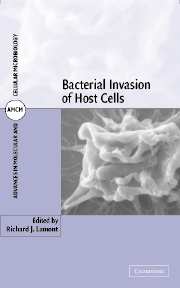Book contents
- Frontmatter
- Contents
- Contributors
- Preface
- Bacterial Invasion of Host Cells
- 1 Invasion mechanisms of Salmonella
- 2 Shigella invasion
- 3 How Yersinia escapes the host: To Yop or not to Yop
- 4 Stealth warfare: The interactions of EPEC and EHEC with host cells
- 5 Molecular ecology and cell biology of Legionella pneumophila
- 6 Listeria monocytogenes invasion and intracellular growth
- 7 N. gonorrhoeae: The varying mechanism of pathogenesis in males and females
- 8 Group A streptococcal invasion of host cells
- 9 Invasion of oral epithelial cells by Actinobacillus actinomycetemcomitans
- 10 Invasion by Porphyromonas gingivalis
- Index
- Plate section
- References
8 - Group A streptococcal invasion of host cells
Published online by Cambridge University Press: 21 August 2009
- Frontmatter
- Contents
- Contributors
- Preface
- Bacterial Invasion of Host Cells
- 1 Invasion mechanisms of Salmonella
- 2 Shigella invasion
- 3 How Yersinia escapes the host: To Yop or not to Yop
- 4 Stealth warfare: The interactions of EPEC and EHEC with host cells
- 5 Molecular ecology and cell biology of Legionella pneumophila
- 6 Listeria monocytogenes invasion and intracellular growth
- 7 N. gonorrhoeae: The varying mechanism of pathogenesis in males and females
- 8 Group A streptococcal invasion of host cells
- 9 Invasion of oral epithelial cells by Actinobacillus actinomycetemcomitans
- 10 Invasion by Porphyromonas gingivalis
- Index
- Plate section
- References
Summary
Group A streptococci (GAS), Streptococcus pyogenes, are beta-hemolytic, Gram-positive, pyogenic cocci that usually grow in chains. S. pyogenes is classified as group A based on serological reactions with its C carbohydrate, which consists of polymers of rhamnose substituted with N-acetylglucosamine (Lancefield, 1933). For epidemiological purposes, GAS are further classified into more than 100 different types based on serological reactions with the variable domains of M proteins, or, more recently, based on 5′ emm gene sequences (Beall et al., 1996). Other typing schemes based on serological reactions with serum opacity factor, T proteins, and R proteins are also used (Johnson and Kaplan, 1993).
S. pyogenes is almost exclusively associated with humans and commonly causes a variety of diseases, including pharyngotonsillitis, impetigo, scarlet fever, and more severe infections, such as puerperal sepsis, myositis, necrotizing fasciitis, and toxic shock syndrome. Among several of the nonsuppurative complications of group A streptococcal infections are acute rheumatic fever and acute glomerulonephritis, which are usually preceded by infections of the throat and skin, respectively. These sequelae are thought to be due to autoimmune T-and B-cell responses induced by streptococcal products. Accumulating evidence also suggests that group A streptococcal infections may lead to other autoimmune diseases, such as obsessive compulsive disorders, or they may exacerbate others such as guttate psoriasis (reviewed by Cunningham, 2000).
ADHESION: PRELUDE TO INVASION?
To establish these infections, the streptococcus must first attach to the epithelium of the host.
- Type
- Chapter
- Information
- Bacterial Invasion of Host Cells , pp. 239 - 274Publisher: Cambridge University PressPrint publication year: 2004
References
- 1
- Cited by



